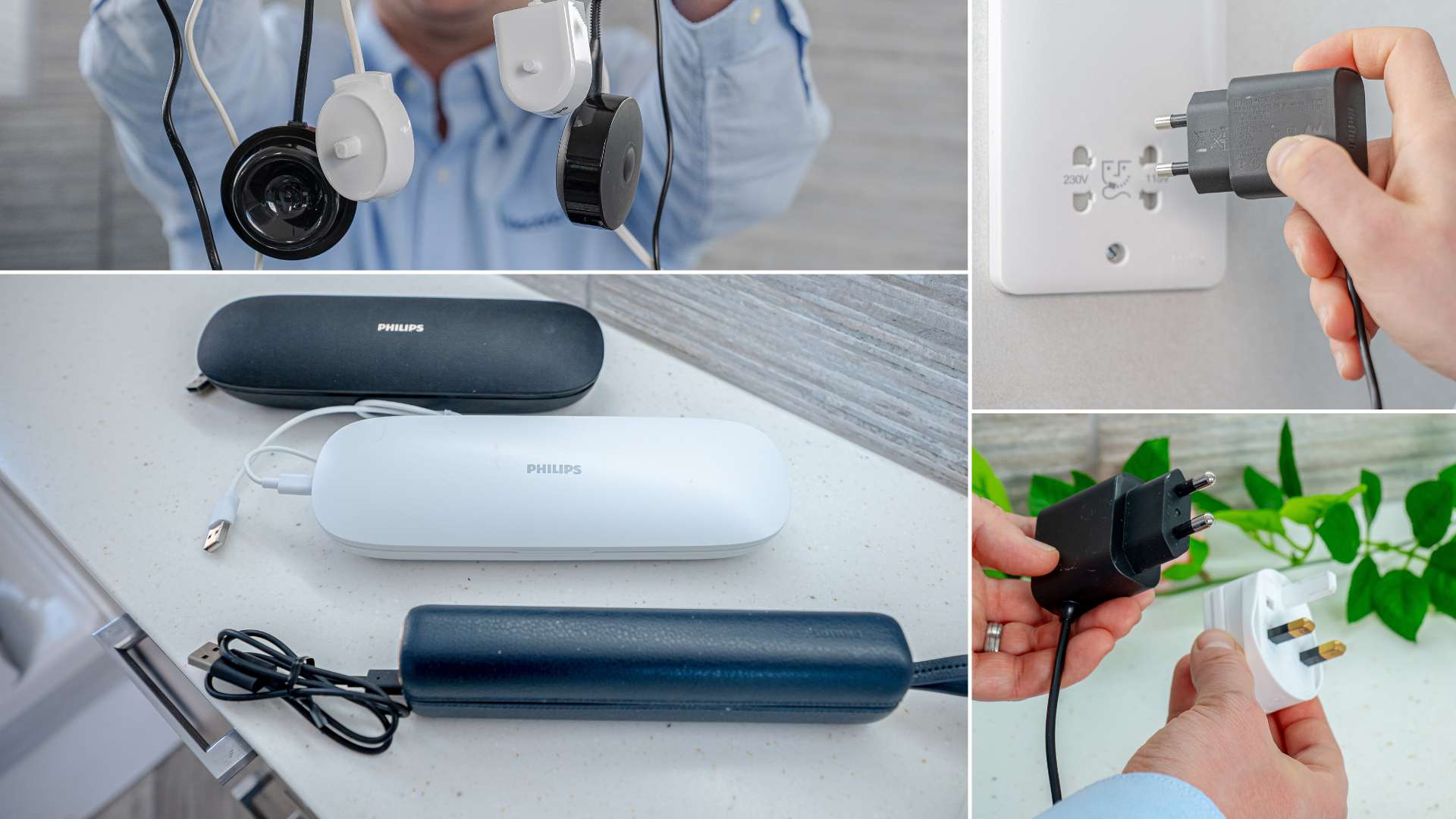
If you are about to go away on holiday, for work or any other reason and you want to know whether your electric toothbrush can work in a foreign country, then we have the answer for you right here.
The reality is that most electric toothbrushes can be used abroad without issue.
Quick reference/check
Take a look at the base of your toothbrush charging stand to see which of these voltages are labelled. Refer then to the table to see what you need.
| Labelled Voltage | Where can it be used? | Do I need a voltage convertor? | Do I need a plug adapter? |
|---|---|---|---|
| 100-240V | Globally | No | Subject to country |
| 220-240V | In countries with 200-240V (e.g. most European countries, NOT US/Canada) | Yes if the voltage of the country you are travelling to is less than 220V | Subject to country |
| 110-130V | In countries with 110 volts (e.g. US/Canada) | Yes if the voltage of the country you are travelling to is higher than 110V | Subject to country |
Explanation
The whole differing power, voltage and adapters can all get a bit confusing.
Subject to your brush and where you are using it will affect what you need to make it charge abroad.
There are 5 key things to consider.
- Do you need to take your charger with you?
- What voltage is the electrical supply in the country you are travelling to?
- What voltage does your electric toothbrush charger support?
- Do you need a voltage converter?
- Do you need a plug adapter?
1. Do you need to take your charger with you?
The first thing to consider is how long are you going to be away/travelling for.
Aside from an electric toothbrush powered by removable batteries, most brushes last no longer than 2 weeks based on one user cleaning their teeth twice a day for 2 minutes.
Every brush model potentially has a different battery life to the next model, so consult your manual or the manufacturer to find out how long your battery will last.
If you are going on a 2 week holiday and have an electric toothbrush with a 3 week battery life, do you need to take the charger? Probably not, especially if you charge it before you leave.
If you are going away for 2 weeks and have only a 2 week battery life you could risk running out of power. You might want to take the charger.
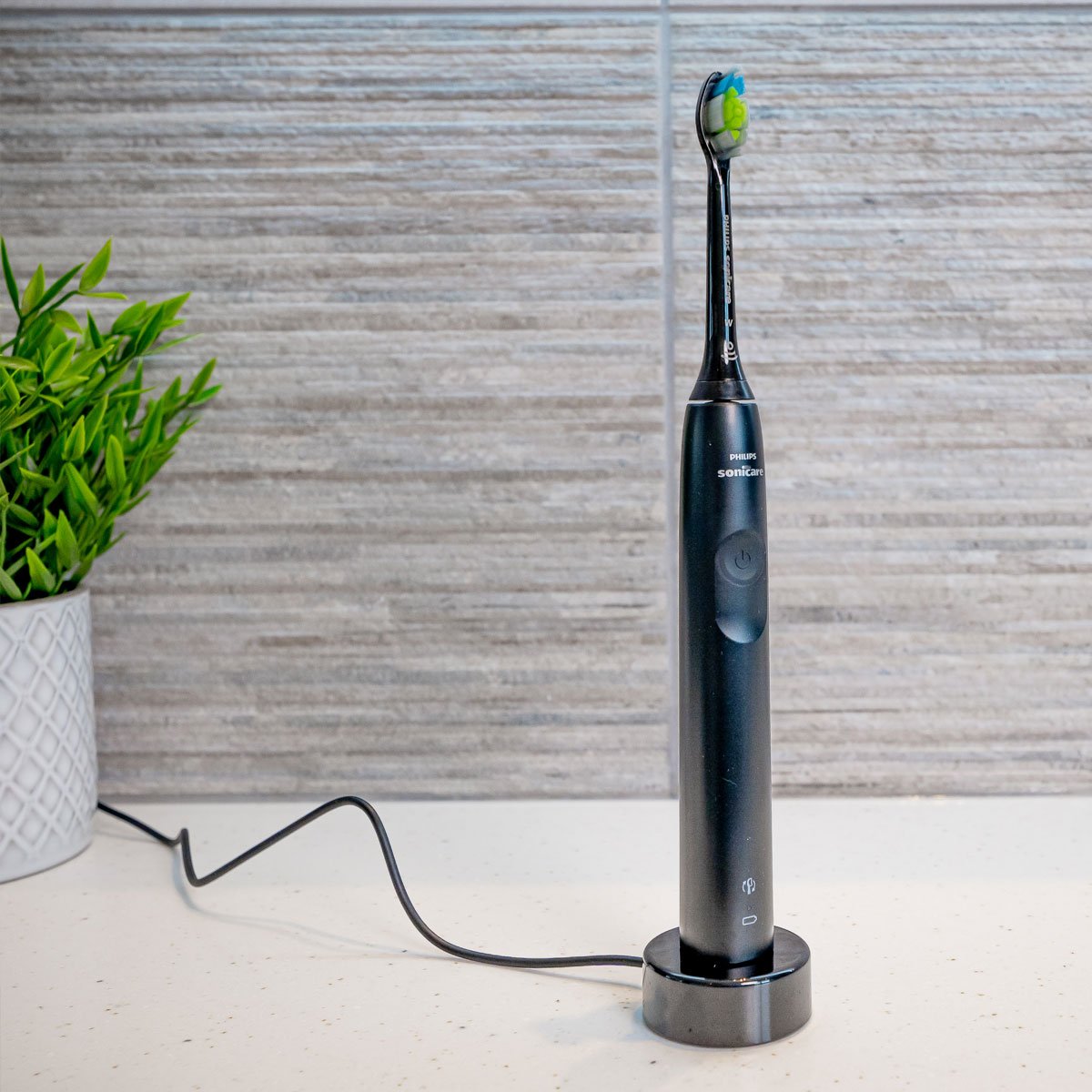
2. What voltage is the electrical supply in the country you are travelling to?
Different countries around the world potentially have different electrical systems to the one you are used to at home. This includes the current/voltage that is delivered to the sockets and the plugs/connectors on appliances.
Many countries in Europe have a voltage of 220-240V, whilst in the USA and Canada it is 110v.
This website offers up a really useful guide to the voltages used by different countries around the world.
Once you have figured out the voltage you now need to check your electric toothbrush to ensure you can be prepared for charging your brush in that country.
3. What voltage does your electric toothbrush charger support?
To check what voltages your electric toothbrush charger supports it is best to get hold of the charging stand and take a look at the labelling, usually found on the underside.
Whether or not you can use your charger in a particular country depends on what your brush states is the required voltage. You need the charger to include the voltage of the country you are travelling to.
So if the country’s voltage is 220v and on your brushes charging stand it states 100-240 or 220-240v everything is good. You can use that charging stand.
If the country's voltage is 110v and your charger states only 220-240V then this will not work, you will require a voltage adapter/converter.
Some electric toothbrushes come with premium travel cases that allow the brush to be charged in the case, rather than on a charging stand. The Oral-B iO Series 9 and DiamondClean 9900 Prestige are 2 examples. Their chargers normally support 100-240v. Worth considering if you have such a model and the normal charging stand does not have a such a wide voltage support.
4. Do you need a voltage converter?
If your charger has support for the country's voltage then you will not need a voltage converter.
If you however had a charger that for example supported 220-240V and you are travelling to a country with 110v power, you will need a voltage converter.
This special piece of technology will allow your brush to be charged on different electrical currents, by either stepping up or stepping down the power, subject to your charging stand and where you are travelling to.
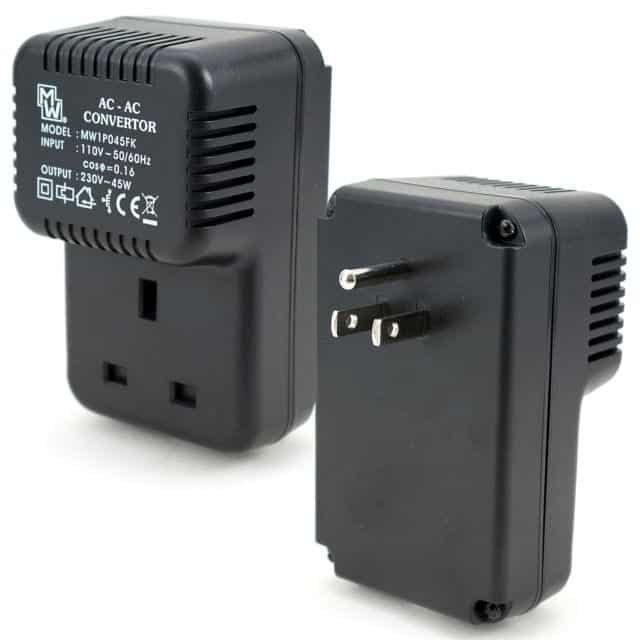
You can buy these from various retailers online or in the high street.
Do your research on the voltage in a particular country to ensure you are getting the right converter.
In the instances where the voltage in the country you are travelling to is lower, you need a ‘step up’ converter and when the voltage is higher you need a ‘step down’ converter.
Once you have a voltage converter you might need to consider whether you need a plug adapter.
5. Do you need a plug adapter?
A plug adapter is an item that allows an appliance from one country to be plugged into the wall outlet of another country. It converts for example a 3 pin UK mains plug to allow it to connect to a 2 pin European mains socket.
It is subject to your home and destination country but it is quite likely you will need a plug adapter. You need to consider what plug you have on your charging stand.
These plug adapters do not change or convert the voltage.
Therefore you may need to plug voltage converter and a plug adapter.
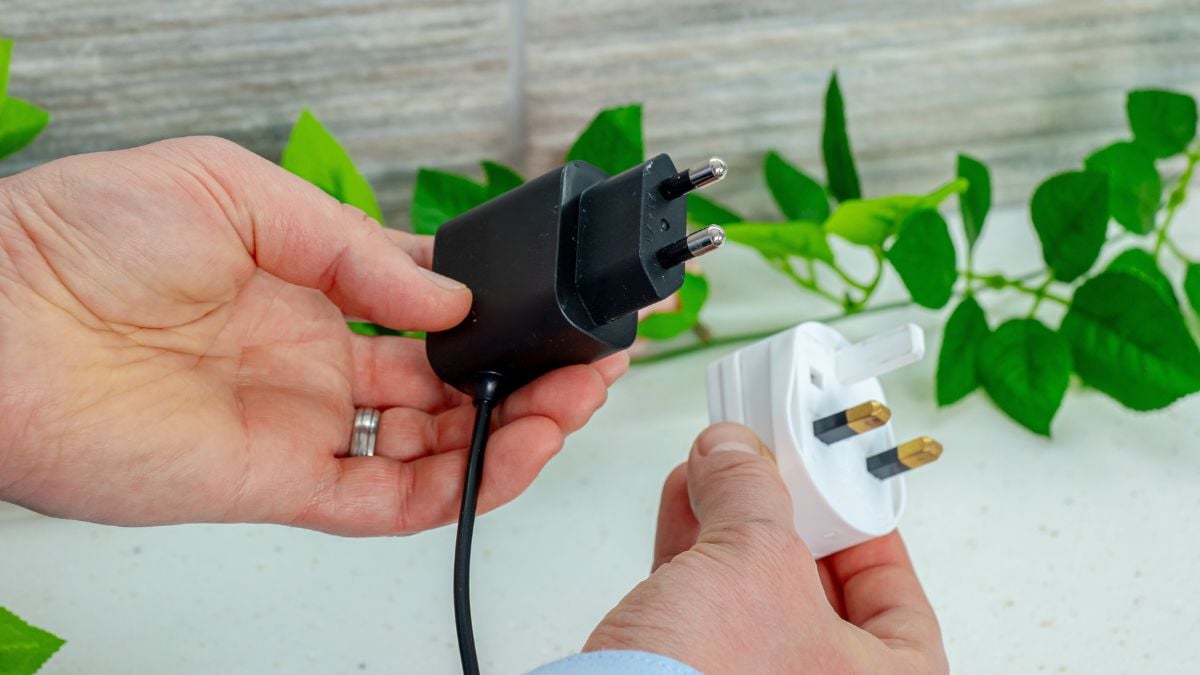
I need a voltage converter and plug adapter
It is quite possible you will need a voltage and plug adapter. This is particularly common for UK residents travelling to the USA or Canada as one example.
In the UK, our electric toothbrush chargers normally come with a 2 pin connector that is different to the 2 pin European mains power adapter and the 2 pin US mains adapter.
If as a UK resident, you are travelling to the USA, you will need a voltage adapter. It is likely that this voltage adapter will connect to the US mains, but offer up a 3 pin UK plug socket. You will then need a 2 pin to 3 pin adapter into which you can connect your toothbrushes charging cable.
Travelling examples
UK residents travelling to France or Spain will need only a 2 pin plug adapter as the voltage is the same as the UK but the plug connection is different.
A Spanish resident travelling to France would not need a voltage or plug adapter as the voltage and plugs are the same.
UK residents travelling to the USA or Canada will require a voltage adapter/converter as well as a plug adapter.
USA/Canadian residents travelling to Europe will require a voltage adapter which will work is most in most European countries that have the two round plug ends. If travelling to the UK you will require another plug adapter due to the different style power outlets.
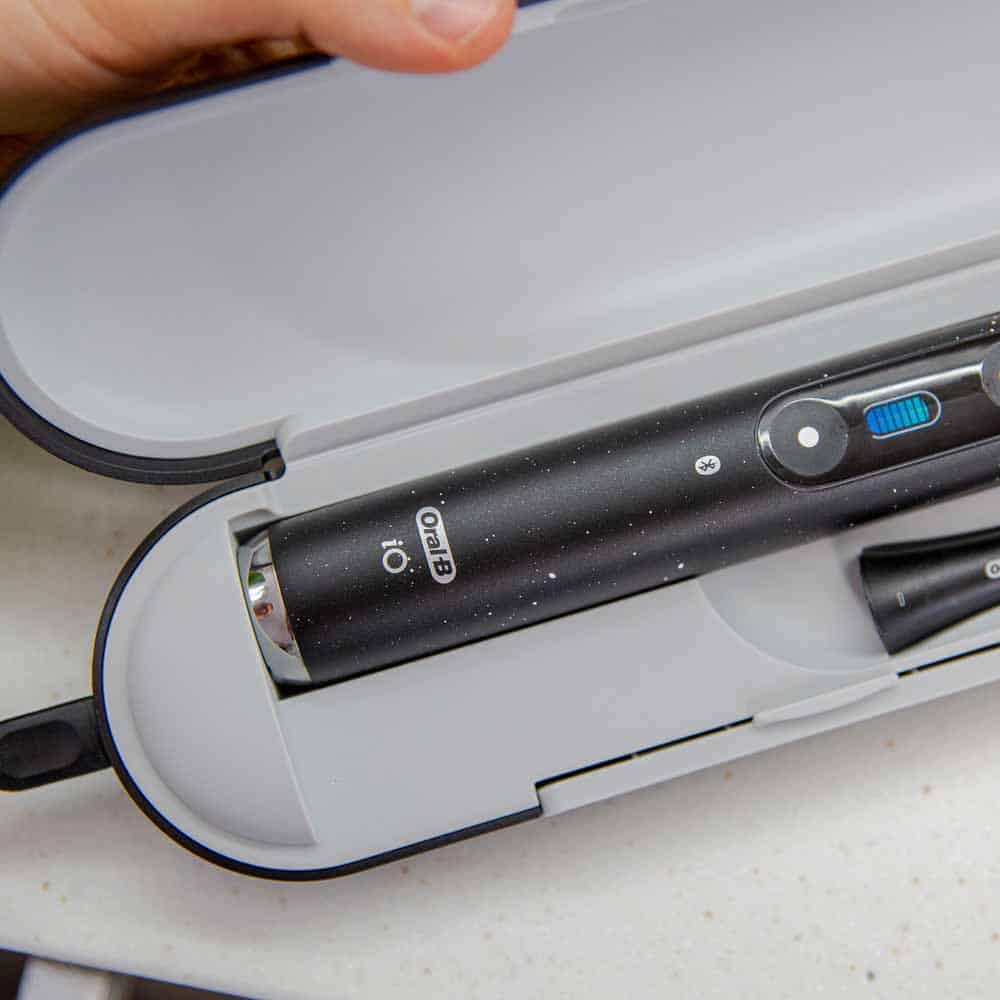
Buy a new charging stand for extended stays
If you are staying in a country with a different voltage or plug system for an extended period of time, it might be worth purchasing a brand new charging stand for your brush that is designed and configured to work with the mains supply in the country in which you are within.
Speak to your brush manufacturer to find out if this is possible and how to buy one.
Please note. This is a guide only and intended to help you ensure you are making the right decision and are prepared for travel. You should do your own research and speak to the brush manufacturer or consult the manual for further information. Electric Teeth endeavour to provide relevant and accurate information, but cannot be held responsible for any incorrect information.



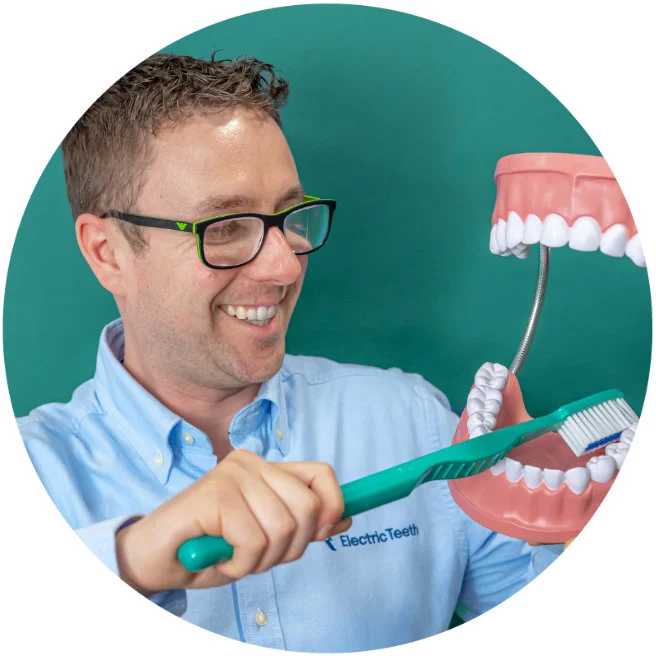

I just purchased a Phillips Sonic Care toothbrush, Model HX6100, and on the bottom of the base, it reads “100-240V a.c. 50/60Hz, 0.4-1.4W.” I also bought an Anker Power Extend USB plug with an AC outlet (for our toothbrush I hope), that has a two-pin plug for use in Europe (we’re going to be in Spain). This device’s electrical rating is “240V MAX, 50/60Hz, 10A MAX, 2400W MAX.” I just want to know that I can use this to plug my toothbrush in and then the device can be plugged into a wall outlet in Spain. Thank you!
Hi Debbie. It sounds like what you have is going to work, but without seeing the items specifically, I can't give you assurances. Are you travelling from the USA? Am I correct in thinking that the charging stand for your electric toothbrush has a 2 pin US power adapter on it? Is this the Anker product you purchased? If the answrr is yes to both these questions I am confiednt everything will work.
I am in Costa Rica with OralB electric toothbrushes. The charger units and brush were bought in the UK . The base of the charging unit shows 220 to 240 V. I have a voltage converter and an adapter, but the brushes will still not charge. Have you any other advice? Many thanks in advance. John Browett
Hi John. If you have both a voltage and plug adapter then I have to say I am not sure as to why that might be I am afraid.
I can't seem to find a voltage converter online anywhere that has support for an electric toothbrush. (travelling from UK to US/Canada so need 220-240V down to 110-120V) Can anyone send me a link to one?
Have you considered Callum just getting a new charging stand instead? So you buy a 2 pin US/CA charger and place your UK electric toothbrush on this?
My electric toothbrush supports 220-240v 50Hz power supply. It has a 2-pin plug which plugs into a shaver adaptor. Will this 2-pin plug fit Spanish sockets or do I need an adaptor?
I think you will need an adapter.
Hello - my rotadent electric toothbrush isn’t charging while I am in Qatar. I will be here for 10 months. The charger base says 100-120 VAC AND 50-60 Hz. I have standard adapters that I’ve been using for my phone and computer but my toothbrush still will not charge - it gives me less than a minute of spinning action and then it’s just dead. I’ve kept it plugged into these adapters but it’s not working. Thank you for any advice you might have on this!
Hi Anne. The power supply voltage in Qatar by my understanding is 240V. Your toothbrush charger supports 100-120v, and is therefore not configured to support the higher voltage offered by the mains power supply. Does the adapter you are using also adjust the voltage too? If so, then it should be working. If not, this could be a reason why. It might be that you are using just a plug adapter, to change the pin configuration. Your phone and computer power adapters support the different (higher) voltage and therefore they have charged fine, because they support this.
Thank you for the great info here. I currently don’t have an adapter that adjusts voltage for me, to recharge my electric toothbrush. Can you recommend one? Thank you again. Sincerely, Anne
Anne. To be honest there isn't 1 I specifically recommend. I am not overly familiar with the best online stores in Qatar, so it is probably going to be best to do a local search for one on or within those stores. You might find a local electronics store may have them.
I have bought and successfully used a 220v EU Oral B charger ( to do the same as a us 3757 charger) on my Broan Oral B 1500. I will be traveling to the UK this spring. Can I use the 220v EU charger with a simple EU to UK plug converter for the UK system?
Hi Richard. Yes, you can do this. Just be aware that the traditional 3 pin UK plug sockets are not found in UK bathrooms. Therefore to charge the brush you will have to place the toothbrush and the stand, in another location where a 3 pin socket will be placed. Hotel rooms will have plenty of these in the main room (outside of the bathroom).
Thanks much Jon. Your blog here is very useful.
Dear Jon, Here's my concern: Virtually every voltage converter, e.g. from 110-120v in US to 240v for use in Europe, mentions NOT leaving it, the converter, plugged in for long periods as they reference using hair dryers, irons and coffee makers -- electric toothbrushes are not referenced as an electrical appliance. Those listed appliances would technically be "OFF" when not in use and NOT receiving a charge, right? So is it safe for anyone charging their US-made 110-120v toothbrush whilst overseas to actually leave it plugged in and charging 24/7? Should we all only be charging the toothbrush through its converter for a 15-30 minute period, let's say once in the morning and once again at night before retiring? Nobody has really addressed this point across all the sites including the Oral B on-line site. Thank you so much for finding out for me.
Hi Peter. I cannot give you confirmation that it is 100% safe to leave a toothbrush on charge 24/7 using a power adapter/converter. I don't think anyone could say it is, there is always a 'potential' risk. However, European electrical systems usually have safety mechanisms such as fuses and breakers to help give extra protection, should the worst happen. It is not necessary to leave a toothbrush on charge 24/7, but many do. Most toothbrushes charge fully within about 12-15 hours (some do take longer). Most also have cut-off mechanisms to stop drawing power. I have personally purchased US (110-120V) toothbrushes and charged them here in the UK, using a voltage converter. I have left the brushes on charge for 12+ hours, without issue. The converter does get warm but I have not had any safety concerns. To be honest, I have not left it on charge overnight and generally, I am within the house when I have done this. I must have completed this 30+ times to date. To summaries, I believe this is a viable solution for a few weeks or even a couple of months, but if you were to be in the UK or overseas for an extended period, picking up a local charging stand is more likely to be safer as there are fewer failure points. I would generally suggest disconnecting it when out of the house etc and not leaving it plugged in 24/7. I hope this helps.
Thank you so much for your time and trouble. One last thing: I think I read either on your great site or, more likely, on the Oral B FAQ site, that for one individual, across 2 minutes of brushing, an electric toothbrush (ET) should last 30 days (or is it hours? I can't recall) on a full charge. First issue with that data: There's no acknowledging that people often brush twice a day so that should cut the overall time of the ET holding its charge in half, yes? And, second, traveling in general might conceivably involve two or more people using one ET motor-section (with their own individual toothbrush heads placed on top) and now we're cutting the time in half and even in half again. So, what have you determined for the Oral B w. Timer (Type: 3 709), 110-120v is the total holding charge time based on one person, using it twice-a-day, for 2 minutes per brushing (and thereby, NOT even needing to take or "convert" the base charger unit overseas on vacation because the ET will hold the charge for 4 minutes a day x ___________ (how many days?) . That's the most pertinent piece of information I do not know. Again, thank you so much to your assistance. Best, Peter
Hi Peter. No Oral-B electric toothbrush I have come across or tested lasts 30 days or hours on a full charge. At the time of comment, the longest battery life of any electric toothbrush Oral-B offers is 'up to 2 weeks' which in reality means (from my hands-on testing) the brush will last for 16 days. That 16 days is based on 1 user, brushing twice a day for 2 minutes each time. So essentially 64 minutes of running time or 32 brushing sessions. Taking this example, if you shared the brush handle with another user, as you would be increasing the daily use of the brush, it would last 8 days between charges. When manufacturers quote battery life, they usually base it on the user brushing twice a day for 2 minutes. So if they say it has 10 days battery life, that means it would last 20 brushing sessions or 40 minutes in total. The Oral-B 3709 which you refer to I think is what is more commonly known as the Oral-B Vitality (as shown in this article). This brush has a 5 day battery life, based on 1 user. This means it runs for 20 minutes in total or 10 brushing sessions each 2 minutes in length. So, if you were to share this with a second user, it would be every 2 days you would really need to charge the brush. I hope this answers the query. If you need further information, just let me know.
Can you tell me if the oralb 9000 toothbrush (comes with a uk charger) can be charged on a US phillips sonicare easy clean charger. Thanks in advance!
Hi Tracy. No, the Oral-B brushes can't be charged off of a Sonicare charger. You can buy US versions of the Oral-B charger if this would be more suitable.
I live in Jamaica and will therefore have to buy my electronic toothbrush in US. I am considering buying Phillips Sonicare Pro2 2500 I travel regularly yo UK will I have any problems with the voltage?
Hi Judith. Thanks for the question. If you are buying from the USA, you are unlikely to be able to buy the Oral-B Pro 2 2500 as this is not sold in the USA. There are similar models from Oral-B but they are different. If you travel regularly to the UK, you can buy it here of course. The charging stand that comes with this Pro 2 2500 model supports UK voltage only. So, to use it in Jamacia you will need a voltage converter as well as a plug adapter to convert the 2 pin UK charger to 2 pin USA. The simpler solution in my opinion would be to have a USA charging stand and a UK charging stand. The brush will work on both stands, but then you will not need a voltage and plug adapter as using the correct charging stand will solve this issue. I hope that makes sense!
Thank you, I agree two charge stands seem to make the most sense
Hi! I recently moved to Japan from the UK and I have a Oral-B Pro 2 2500N bought in the UK and has a 2 pronged UK shaver plug. What plug adaptor do I need for Japan? I have literally no clue. Please help! Thanking you in advance. Rahmi
Hi Rahmi, It is my understanding that for the most part, in Japan, the same 2 pin plug as the USA is used. Whilst there are ways and means of converting your 2 pin UK charging stand to fit and work with the Japanese mains power, it is probably going to be better to buy a new charging stand. You are looking at a stand like this.
Hi Jon! Thank you! That was very helpful. All the best from Tokyo
Hi Jon, I bought an Oral B 3757 electric toothbrush in Japan which has a US style 2 pin plug attached to the charger base. I brought it back with me to the UK and want to carry on using it here but its run out of charge. I have tried a 3 pin to 2 pin 1A adaptor but it failed to charge the toothbrush. Do I need a transformer? What do you recommend? Any advice would be greatly appreciated. Thanks
Hi Aisha. Thanks for the question. I think what you need is a voltage converter like this. I have one of these that I use to charge brushes I have bought from the USA, here in the UK. I connect the voltage converter to the 3 pin mains socket, plug the charging stand into the converter and the brushes begin charging. There are probably other adapters out there, but I haven't had any issues with this for the last year or so. You could also buy a UK Oral-B charging stand.
Thank you very much for your help Jon, I have successfully ordered the voltage converter.
Hello, I have a Braun Oral B toothbrush that has 220-240 V (50-60Hz) printed on the bottom, and made for use in the UK. Good so far. BUT, it only has a 2 pronged UK shaver plug, so was clearly designed to work on UK shaver sockets, which are 110-120V. How does it work if it only says 220-240V on the base, but it is designed to only plug into the 110-120V socket? Follow up question: If it is indeed the case that it can work in the UK shaver sockets then would I be able to use it in Canada where the power is 110-120V 60Hz? Thanks
Hi Colin, Thanks for the comment. I do believe you might find this article on our website useful. I am not a qualified electrician, but as I understand it, many 2 pin sockets in UK bathrooms, often offer a socket for 110-120V as well as a socket for 220-240V (the labelling may be slightly different) as per this image. What makes you think they are only 110-120v here in the UK? Generally speaking it would not be safe to use the 220-240v charging stand with a 110-120v electricity such as that in Canada and the USA unless you are using a converter to adjust the voltage.
I am trying to work out what plug adaptor I will need for new zealand!
Hi Jenny, In New Zealand, they use Plug Type I - https://www.power-plugs-sockets.com/new-zealand/ I am presuming by the comment you may be in New Zealand for a reasonable amount of time, rather than a week or 2 and need to recharge your brush when there? If so, you may want to get a 2 pin to 3 pin UK power adapter and then connect this into a UK to New Zealand travel adapter. Or I believe an adapter like this will work, but I have not used to tried to give 100% confirmation. Other peoples comments would suggest it works just fine.
I have read and reread your generally very helpful advice, but I STILL can't find details of an adapter that would let me use my Braun 220-240v fitted with a TWO pin plug in Greece where the two mains pins are a different width and distance apart. This should surely be the easiest of all conversions?
Paul, In most instances European bathrooms will have a shaver socket in the bathroom that will accept the 2 pin plug on your charging stand. Failing that, this adaptor should do the job.
Can u send me a link for this adaptior u refer to. I have a holiday home in Spain and brought my electric toothbrush out thinking the 2 pin plug would fit directly into the 2 pin wall plugs but they dont
Ho Joanne. Sorry for the slight delay in reply. I am presuming you normally live in the UK and have travelled to Spain, therefore you have a 2 pin (UK bathroom) connector on your toothbrush charger presently. Whilst you can make use of adapters, I think it would be better for you, as you have a holiday home, to buy a 2 pin EU charging stand for your brush. Cost will likely be about the same, but you need not worry about bulky adapters, just buy a new charging stand. What brand is your toothbrush?
The caption says 3 pin to 2 pin. I'm after 2 pin to 2 pin. ?
Paul, You should see that the lower 2 pin slots are rounded on one edge which should accommodate the 2 pin plug found on your Braun shaving stand. Meaning this should work. Alternatively use a 2 pin to 3 pin plug adapter, as would be necessary if you did not have a power outlet in your bathroom in the UK. Then connect this to a standard 3 pin to 2 pin Euro adapter.
By the way, most holiday accommodation in Greece doesn't have shaver sockets. I've been a couple of dozen times and can't think of anywhere that had them, apart from big hotels.
Thanks, Jon. Quite incredibly clunky. I'm wondering what plug Braun fits to its chargers for the German market, assuming I could buy one, of course.
They offer 2 pin Euro plugs I do believe.
That's a good lead, thanks, Jon, except that Shavers want £20 for an EU plugged version of the charger, whereas it is available for £11.25 via https://www.amazon.co.uk/Toothbrush-Trickle-toothbrushes-compatible-Professional/product-reviews/B00C5NRFY4/ref=cm_cr_dp_d_hist_4?ie=UTF8&filterByStar=four_star&reviewerType=all_reviews#reviews-filter-bar
That's great Paul if you managed to get it cheaper. Its not clear that the plug provided there is an EU 2 pink connector, but I hope it works out for you.
Hello Jon, Doing a search for other eletronics (videogames, for instance), I found some reports saying that there are electronics sold in Europe as 220-240V, however, they are actually 100-240V. From what I read, they are claimed to be 220-240 V in Europe for legal reasons. I friend told me the other day that she charged her Oral B (which is suppose to be 220-240V) in the US with no problem. Are we sure that the chargers of the Oral B sold in Europe are not actually bivolt (even though the charges say 220-240V)? WOuld there be a way to test it? thanks a lot! Best
Hi John. Thanks for your comment. I am no legal mind or electrician to confirm 100%. I would imagine its possible some items would work but they may not perform correctly or be at risk of damage. It would seem odd to claim 220-240v but work on 110v voltages in the USA for example, particularly as they offer different currents of electricity. Philips Sonicare for example offer charging stands that specifically state 100-240v support whilst Oral-B specifically state 220-240v. Why not claim wider support? I am not sure how your friend charged her toothbrush in the USA. Did she take her EU stand and use nothing more than a plug adapter. I have used brushes like the Oral-B Pro 1000 released in the USA on a UK charging stand and it worked and charged fine. I have also used a UK released brush like the Pro 2 2000 on a US charging stand, but with a voltage and plug adapter here in the UK. Sadly I have not been to the USA of late with brushes to test first hand. I suspect there are voltage meters and people with more experience that might be able to add to this conversation but I am not trained in this area to go beyond what I have.
Hi Jon, thanks for the article. I still have a question. I have two chargers, both for Oral B. One is 110V and the other 220V. Can I use the same toothbrush with both chargers? Or the internal battery of my toothbrush only supports one voltage or the other? Thanks
Cris, I am not sure what the 'technically correct' answer is, but I have previously completed some brief testing and managed to charge Oral-B brushes on either a 110 and 240v charger.